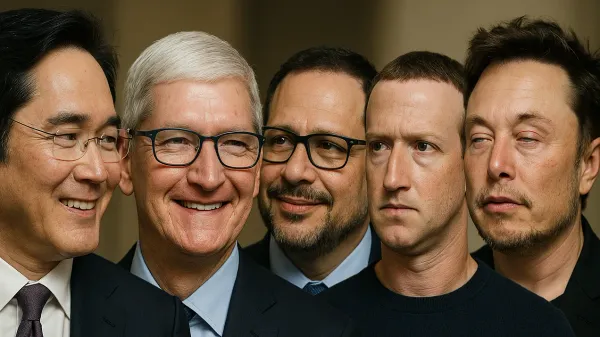In Brazil in the late 1980s, as the Soviet Union began to fall apart, K.G.B. agents walked into municipal government offices and filed birth certificates for babies who didn’t exist. These birth certificates and the identities based on them weren’t forged or backdated. They weren’t even meant to be used anytime soon.
They were planted.
As the NY Times reported today, decades later, Russian operatives operating under deep cover, posing as Brazilian nationals, have surfaced across Europe and the Americas with these perfectly aged identities. The records had been lying dormant, invisible and unquestioned, until they were needed. It may have been a Cold War insurance policy. A long shot, seeded early. No immediate return. No certainty of survival. Just strategic conviction.
This is not an article about espionage. It’s about strategic foresight.
The most dangerous people and the most dangerous companies are not the ones making noise. They’re the ones making moves that won’t make sense to anyone else until it’s too late.
And that’s the part most businesses miss.

The Myth of Strategy in Real Time
Most companies don’t actually have a long-term strategy. They have a series of decisions that seem justified by short-term data. Budget season changes their direction. New leadership resets their vision. Press releases masquerade as plans.
The issue isn’t that they don’t think strategically, it’s that they abandon strategy the moment it becomes inconvenient.
This isn’t a new problem. But it’s getting worse. With investor pressure for immediate returns, internal KPIs that reward optics over outcomes, and a media environment that valorizes pivots, many firms are trapped in a cycle of reactive decision-making. Strategy becomes synonymous with flexibility, not with foresight.
But the companies that truly win—the ones that reshape industries or outlast louder competitors—operate differently. They:
- Hold conviction through volatility.
- Delay gratification for asymmetric advantage.
- Build capabilities that don’t make sense to others—until they do.
This kind of patience is rare. It feels irrational in the moment. But over time, it becomes the reason they survive when others don’t.
Companies That Filed Early Birth Certificates
The companies that truly play the long game risk looking out of step in the moment. They take actions that seem excessive, misaligned, or unprofitable—until they aren’t. Like the K.G.B. operative planting a birth certificate in a forgotten ledger, they invest in assets that may appear unnecessary today, but become decisive later.
Let’s look at a few real-world cases of businesses betting on the distant future and sticking with it.
Amazon
For nearly two decades, Amazon prioritized customer infrastructure over profit. While retail competitors measured same-store sales, Amazon built fulfillment centers, logistics software, and web services capabilities. Walmart had the cash, the footprint, and the dominance in physical retail. Amazon sacrificed profits year after year to build something Walmart couldn’t match: distribution reach with no real estate drag.
The key move wasn’t a flashy product; it was the quiet, cumulative buildout of what Bezos called the “flywheel.” More selection led to more customers, which attracted more sellers, which drove down prices and improved experience, which fed back into growth.
By the time Walmart realized e-commerce wasn’t a side bet, Amazon had already won the digital shelf. Amazon didn’t beat Walmart by being better at retail. It beat Walmart by playing a different game—and starting early enough that by the time Walmart reacted, it was already behind.
Toyota
In 1997, Toyota launched the Prius—the world’s first mass-produced hybrid car. At the time, fuel was cheap, emissions were an afterthought in most markets, and consumers weren’t asking for alternative powertrains. No one was seriously investing in hybrid systems. There was no market pulling for it.
Toyota made the investment anyway.
The move was strategic and generational. Toyota spent years developing proprietary hybrid-electric technology, refining battery systems, and reshaping its engineering talent pipeline, all before it was commercially obvious. Toyota was betting on a future where fuel efficiency and emissions standards would become decisive market factors.
It took years before the bet paid off. But when fuel prices spiked in the mid-2000s and governments began regulating emissions more aggressively, Toyota had a commanding lead: technologically, operationally, and reputationally.
The Prius wasn’t just a product. It was a birth certificate filed in advance.
Even when your market hasn’t caught up yet, it’s possible to test whether your assumptions are coherent, your thesis holds water, and your competitors are asleep.
That’s where rigorous external intelligence earns its keep.
If you're working on something the market doesn't understand yet, neither do your competitors. We'll help you find the gaps, challenge your assumptions, and sharpen your long-game.
Netflix
Netflix pivoted from DVD rentals to streaming before the economics worked. It cannibalized its own profitable business. In 2007, the streaming catalog was thin, user behavior was unproven, and bandwidth was a constraint. But the leadership team understood that whoever got to scale first in digital would control distribution in the future.
They were right. Netflix not only beat Blockbuster, it now sets the terms for the entire streaming industry. It did so by making a strategic move before the conditions justified it. Another birth certificate, quietly filed.
TSMC
While Intel expanded into consumer products and branded CPUs, Taiwan Semiconductor Manufacturing Company focused on one thing: being the world’s most trusted foundry. No fanfare. No direct-to-consumer marketing. Just a 30-year investment in process technology, capacity, and customer trust.
That patience paid off. Today, even Intel must rely on TSMC for cutting-edge chips. The quiet foundry is now the most important node in the global tech supply chain. No one noticed. Until everyone had to.
Each of these companies succeeded not by reacting quickly, but by acting early and enduring long enough for the future to arrive. They made decisions that wouldn’t be rewarded for years.
The Foresight Playbook
You can’t imitate long-term strategic winners by copying their outcomes. What you can do is reverse-engineer the discipline behind their decisions. They built capabilities others wouldn’t value for years. And they kept building through irrelevance, internal resistance, and even external ridicule.
Here’s a distilled version of how they play the game:
P.L.A.N.T. – A Framework for Strategic Foresight
Patient Capital Allocation
Allocate resources to initiatives that don’t have to show immediate ROI. The goal is not to subsidize inefficiency but to build optionality. Logistics networks, supply chain integration, core R&D, or ecosystem groundwork. If it feels premature, it might be right on time.
Leap Early
While “market validation” is important, when the goal is category leadership the market may lag in its ability to provide validation. The players making early moves: Netflix with streaming, Toyota with hybrids, Amazon with e-commerce logistics did not wait until the need was obvious.
Asymmetric Bets
Not all risks are equal. Smart long-term strategy involves taking small-to-medium bets on moves that could create disproportionate advantage if the environment shifts. This is what Pfizer does with its pipeline or what TSMC did by staying out of branded chips. Don’t hedge everything. Place bets where the upside justifies the wait.
Narrative Discipline
Stay on-message internally and externally. Long-term strategy is often misunderstood, even by your own rank and file. These companies didn’t panic when analysts doubted them or the press criticized them. They stuck to a core thesis and kept executing.
Trigger Readiness
Timing can’t be controlled, but preparation can. When conditions flip (fuel prices rise, regulations change, digital infrastructure becomes ubiquitous), the companies that “get lucky” are often the ones who built quietly for a decade.
This is a method that filters out distractions, withstands performance dips, and builds toward an advantage that seems obvious only in hindsight.
The hard question: what are you planting?
I work closely with firms who aren’t looking for demand validation. Instead they’re looking for proof that the path they’re on is misunderstood, underappreciated, and still wide open.
Are You Thinking in Decades or Quarters?
Most strategy decks are written for next year. The best ones are written for a moment that hasn’t arrived yet, but will. The firms that dominate their industries a decade from now are likely doing unglamorous, unrewarded things today: rewriting core processes, investing in infrastructure that doesn’t yet pay off, launching initiatives that feel too early.
It may even look like wasted effort, until suddenly, it looks like inevitability.
That’s the lesson of the birth certificate.
A planted asset that seemed absurd, until it worked. Until someone showed up with an airtight identity.
So the real question is:
What are you building today that your competitors won’t understand for 5-10 years?
Long games are lonely. So is strategy that doesn’t fit into next quarter’s template.
If you’re building something the world won’t reward for years, we can help you ask—and answer—the right questions anyway.
Not just 'Where’s the market?’ but ‘What am I actually seeing that others aren’t?’
If your current strategy feels slightly irrational, slightly premature, slightly overbuilt for current conditions, you may be on to something.
The payoff will never feel urgent. That’s the point.
You win by filing early.







